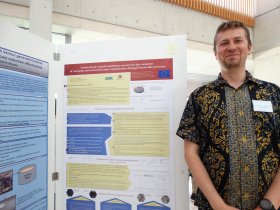Oleg Dubov


PhD Programme: Nanoscience, Materials and Chemical Engineering
Research group: PISET – Process Intensification, Simulation & Environmental Technology
Supervisor: Josep Font Capafons
Bio
Oleg Dubov has studied Chemistry (bachelor degree) in St-Petersburg State University, Russia, where he developed the thesis “Synthesis and characterization of a novel polyacrylic chelating ion-exchange fiber material for heavy metals removal from water”. After her bachelor degree, he takes a master in Global Management of Innovation and Technology at Lappeenranta University of Technology, Finland. His master thesis was about the profitability of recycling of small electronic devices for recovery of critical materials. Dubov has a seven years work experience in different companies, such as the BTP group of companies. The group of companies includes Swiss, Russian, Finnish, Italian and Chinese engineering, production and marketing enterprises. As a head of R&D department, he was in charge for all the innovative and technologically challenging projects.
Project: Semi-amorphous carbon nitride films derived from soluble polymeric precursors
In the recent years the demand generated by newborn electrochemical industries related to green energy resulted in increased interest in different forms of carbon-based materials became a new hotspot in the electrode science. However, in spite of appealing industrial and economic convenience of carbon-based support materials, their oxidative stability in most cases is much lower compared with the resistance to oxidation of noble metals and even metal oxide systems. Nevertheless, two families of materials belonging to the group of carbon-based supports represent an exception to this general rule - glassy carbons and carbon nitrides. The so-called glassy (or vitreous) carbons, produced by means of pyrolysis of cheap carbonaceous polymers, possess an exclusive oxidative stability together with high conductivity and chemical inertness. The main reason for this lies in the fact that the pyrolysis process, leading to the formation of vitreous carbon, requires noticeably high temperatures (1000 to 3000 oC Another group of material of the carbonaceous family, distinguished for its high oxidative stability, carbon nitrides, exhibits the combination of properties making it nearly antipodean to vitreous carbon. The pyrolysis temperature, in contrast with glassy carbon, is rather low, laying in the 400 to 600 oC range. As a cornerstone for the present thesis, it was hypothesized the existence of a new member of the carbonaceous materials family, glassy carbon nitride, that could be produced by means of pyrolysis of nitrogen-rich polymeric precursors and retain high nitrogen content in the final form. It was also supposed that the material thus obtained would combine the benefits of vitreous carbons and carbon nitride without having their drawbacks. Such a material was efficiently fabricated and various electrochemically stable and catalytically active coatings have been synthesized based on the material.
Open Access publications
- Oleg Dubov, Jaume Giralt Marce, Agusti Fortuny, Azael Fabregat, Frank Stuber, and Josep Font. Flexible semi-amorphous carbon nitride films with outstanding electrochemical stability derived from soluble polymeric precursors. Journal of Materials Science, 2022, 57. View full-text
- PHD THESIS: Semi-amorphous carbon nitride films derived from soluble polymeric precursors
Outreach activities
- European Researchers' Night 2019: "Nanoquímica, el món dels petits".
International secondment
- Technical University Dresden, Germany. 1 month (2021).
News
- Diari Digital de la URV. News: Trobada entre estudiants de la URV i el Nobel de Química Richard Shrock
- Horizon Results Platform: A Method for Producing an S-Triazine or S-Heptazine-Based Polymeric or Oligomeric Materials and S-Triazine Or S-Heptazin



